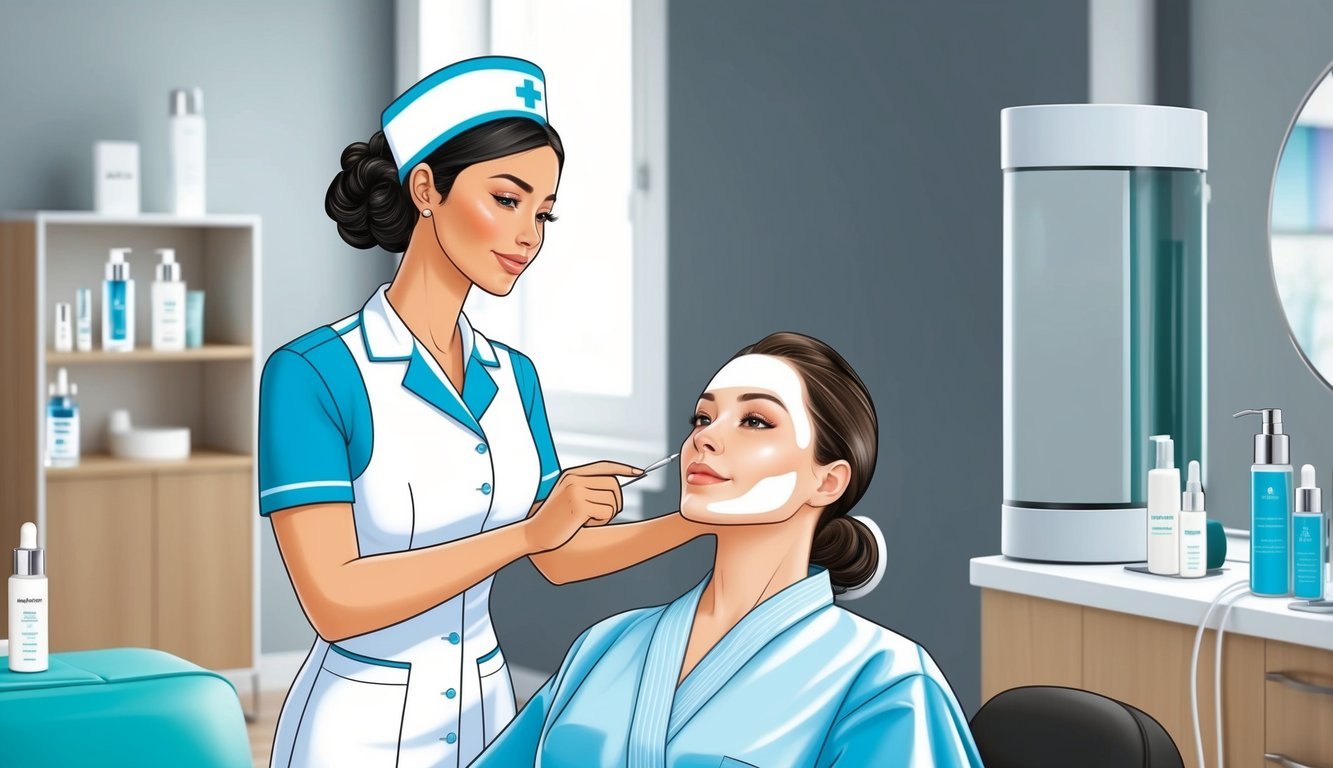Aesthetic nurses play a vital role in the healthcare field by focusing on cosmetic procedures that enhance a patient’s appearance.
An aesthetic nurse is a registered nurse who specializes in providing various cosmetic treatments.
They ensure that patient care is at the center of their practice.
This role has gained popularity as more people seek non-surgical options to improve their looks.
In this growing field, aesthetic nurses may perform a range of procedures, from administering injections to assisting in advanced techniques.
Their expertise allows them to work closely with patients, addressing their needs and goals while maintaining safety and care standards.
You will find that this profession not only requires clinical skills but also involves a strong understanding of aesthetic principles.
By learning more about what it takes to become an aesthetic nurse and the responsibilities that come with the role, you can better understand how this specialty contributes to patient satisfaction and wellness in cosmetic care.
Key Takeaways
- Aesthetic nurses are specialized registered nurses focusing on cosmetic procedures.
- They play a key role in enhancing patient care through various treatments.
- Becoming an aesthetic nurse requires specific training and knowledge of aesthetic practices.
Becoming an Aesthetic Nurse
To become an aesthetic nurse, you must follow a specific educational path, obtain the necessary certification and licensure, and pursue specialized training in the field.
This process ensures that you are well-prepared to provide cosmetic treatments safely and effectively.
Educational Pathways
To enter the field of aesthetic nursing, you must first earn a nursing degree.
There are two common pathways:
| Degree Type | Description |
|---|---|
| Associate Degree in Nursing (ADN) | A two-year program that prepares you for basic nursing practice. It allows you to sit for the NCLEX-RN exam. |
| Bachelor of Science in Nursing (BSN) | A four-year degree that offers more comprehensive nursing education and skills. This path is often preferred by employers. |
Completing either degree will enable you to become a registered nurse (RN).
After graduation, you will need to pass the National Council Licensure Examination (NCLEX-RN) to obtain your nursing license.
Certification and Licensure
Once you hold your nursing license, you can pursue additional certification to specialize in aesthetic nursing.
Organizations like the Plastic Surgical Nursing Certification Board offer certification programs.
To be eligible for certification, you typically need:
- A current RN license
- Relevant work experience in nursing
- Completion of continuing education credits related to aesthetics
Certification enhances your credibility and may improve job prospects in this competitive field.
Additionally, remember to maintain your nursing license through ongoing education and renewal requirements.
Specialized Training
Specialized training in aesthetic nursing is crucial for providing safe and effective treatments.
Many aesthetic nurses participate in training programs that cover various procedures, such as:
- Botox injections
- Dermal fillers
- Laser treatments
- Chemical peels
Joining accredited training programs or workshops can significantly boost your expertise.
These programs often provide practical experience, which is vital for honing your skills.
Attending workshops or conferences in aesthetic medicine can also keep you updated on new techniques and advancements in the field.
Roles and Responsibilities

As an aesthetic nurse, you play a crucial role in patient care and satisfaction.
Your responsibilities include assessing patients, administering treatments, and providing follow-up support.
Each of these areas is essential for ensuring effective outcomes.
Patient Assessment and Care
Your first task involves conducting thorough patient assessments.
This usually starts with a medical screening to review the patient’s medical history.
Understanding any past conditions helps ensure their safety during treatments.
During the initial consultation, you listen to your patients’ goals and expectations.
You evaluate their skin condition, considering factors like texture, tone, and any specific concerns.
This assessment allows you to create personalized treatment plans that align with their needs and desires.
Moreover, you educate patients about the procedures they are considering.
This includes explaining potential risks, side effects, and aftercare instructions.
Effective communication is vital in helping patients make informed decisions about their cosmetic treatments.
Administering Treatments
In your role, you will administer various cosmetic treatments.
This may include injectables such as Botox and dermal fillers, which help reduce wrinkles and enhance facial volume.
Precision and technique are key to achieving natural-looking results.
You may also perform procedures like chemical peels and laser treatments.
Each treatment requires specific skills and knowledge to ensure optimal results while maintaining patient safety.
Preparing the treatment area and following sterile procedures are critical steps in your work.
Before each treatment, you confirm that the patient understands the procedure and its benefits.
You ensure that their comfort remains a priority throughout the process.
Monitoring for any adverse reactions during administration is also essential.
Follow-Up and Post-Operative Care
After treatments, your role shifts to providing follow-up and post-operative care.
You schedule follow-up appointments to monitor healing and results.
During these visits, you assess the outcomes and address any concerns.
You also educate patients about aftercare instructions.
This may involve advising them on avoiding sun exposure or using gentle skincare products.
Continuous communication helps reassure patients and ensures adherence to your advice.
Furthermore, you may perform post-operative assessments if applicable.
Checking for complications or results helps maintain high standards of care and patient satisfaction.
Your goal is to foster a supportive environment throughout their aesthetic journey, ensuring a positive experience long after the initial treatment.
Aesthetic Procedures and Techniques
Aesthetic nurses provide a variety of procedures to help patients achieve their desired look.
These can range from non-surgical methods to more advanced technologies.
Understanding these techniques is essential for anyone interested in aesthetic treatments.
Non-Surgical Procedures
Non-surgical procedures are popular due to their minimal downtime and effectiveness.
Common treatments include:
- Botox Injections: These reduce the appearance of wrinkles by temporarily paralyzing muscles. Results can last 3 to 6 months.
- Filler Injections: These add volume to areas like lips and cheeks. Different types of fillers offer varying effects and longevity.
- Microdermabrasion: This technique exfoliates the skin, improving texture and tone. It uses tiny crystals to remove dead skin cells.
- Dermabrasion: More intensive than microdermabrasion, this technique removes deeper skin layers. It helps treat severe scars and uneven skin.
These procedures can often be performed in a medical spa setting and provide quick results with minimal recovery time.
Surgical Assist Techniques
Aesthetic nurses also assist in surgical procedures.
Their role can vary based on the procedure but often includes:
- Preparing the patient for surgery.
- Assisting the surgeon during the operation.
- Monitoring the patient’s vital signs.
Common surgical procedures include skin resurfacing and tattoo removal.
In skin resurfacing, techniques like laser treatment help reduce wrinkles, age spots, and scars.
For tattoo removal, lasers break down ink particles in the skin, allowing the body to naturally eliminate them.
The aesthetic nurse’s expertise is vital during these processes to ensure safety and optimal outcomes.
Emerging Technologies in Aesthetics
Innovations in aesthetics are continually changing the landscape of available treatments.
Some noteworthy advancements include:
- CoolSculpting: This non-invasive fat reduction technique uses controlled cooling to eliminate stubborn fat cells.
- Microneedling: This procedure involves tiny needles creating micro-injuries in the skin to stimulate collagen production and improve texture.
- Sclerotherapy: Often used for varicose veins, this involves injecting a solution directly into the veins, causing them to collapse and fade.
These technologies present new options for patients seeking effective treatments without surgical intervention, making them appealing choices in a medical spa environment.
Clinical Practice and Employment
Aesthetic nurses operate in various clinical settings, providing specialized care focused on cosmetic procedures.
Their roles are vital in medical spas, dermatology clinics, and plastic surgery facilities.
Understanding these environments helps you grasp the career landscape and opportunities available in this field.
Medical Spas and Dermatology Clinics
In medical spas and dermatology clinics, aesthetic nurses perform non-invasive procedures such as facials, chemical peels, and laser treatments.
They often work alongside dermatologists to enhance patient skincare and aesthetic outcomes.
This setting emphasizes patient consultation, where you explain procedures and set expectations.
It’s crucial to have excellent communication skills.
Typical services include:
- Botox injections
- Dermal fillers
- Laser hair removal
These clinics are in high demand, given the increasing popularity of cosmetic services, leading to a favorable job outlook.
Plastic Surgery Offices and Hospitals
At plastic surgery offices and hospitals, aesthetic nurses may assist with surgical procedures or provide pre- and post-operative care.
Your role could involve patient education, monitoring vital signs, and ensuring patient comfort during recovery.
In this environment, aesthetic nurse practitioners may perform advanced tasks and assume more responsibilities.
This practice allows for a deeper involvement in cosmetic procedures such as liposuction or breast augmentation.
Key responsibilities might include:
- Assisting during surgeries
- Managing patient records
- Administering medications
Working in this environment often leads to a higher salary due to the complexity of tasks and the necessity for advanced skills.
Career Advancement Opportunities
Aesthetic nursing offers numerous career advancement opportunities.
You can pursue certification programs or specialized training to become an aesthetic nurse practitioner.
This role allows you to take on greater responsibilities and perform more complex procedures.
Continuing education can lead to positions in roles such as:
- Clinical educator
- Practice manager
- Cosmetic sales consultant
With a growing job market, the Bureau of Labor Statistics projects a positive outlook for aesthetic nursing careers.
The average salary for aesthetic nurses can vary significantly, with potential earnings from $45,000 to $96,000 depending on your experience and specialization.
Exploring these career paths ensures you can set clear goals for your professional development in aesthetic nursing.
Standards and Organizations

Understanding the standards that govern aesthetic nursing is essential for ensuring quality care.
Various organizations provide guidelines and resources to enhance the skills and knowledge of aesthetic nurses.
Regulatory Standards and Patient Safety
Regulatory standards ensure that aesthetic nurses meet specific qualifications and practice safely.
To become an aesthetic nurse, you must have a valid RN licensure.
Certifications such as the Certified Aesthetic Nurse Specialist (CANS) and Certified Plastic Surgical Nurse (CPSN) are offered by the Plastic Surgical Nursing Certification Board (PSNCB).
Maintaining patient safety is critical.
Aesthetic nurses follow protocols to minimize risks during procedures.
Additionally, organizations like the International Society of Plastic and Aesthetic Nurses (ISPAN) provide position statements that outline best practices for both registered nurses and advanced practice registered nurses in the plastic surgical setting.
Professional Associations and Resources
Several professional associations provide resources for aesthetic nurses.
For instance, the Dermatology Nurses Association and the American Association of Aesthetic Medicine and Surgery offer educational materials, webinars, and networking opportunities.
These organizations play a vital role in supporting your professional growth.
Joining these groups can provide access to current research, training programs, and guidelines to improve patient care in aesthetic practices.
You may also find resources that assist in achieving certifications and staying updated with industry standards.
Incorporating knowledge from these associations can help you provide better care and build a strong professional network.
Frequently Asked Questions
In this section, you will find information regarding the role, qualifications, and training necessary for aesthetic nurses.
Each question addresses specific details to help you understand this nursing specialty better.
What are the primary duties of an aesthetic nurse?
Aesthetic nurses primarily provide cosmetic treatments to patients.
They administer injectables like Botox and dermal fillers.
They may also assist in laser treatments and skin rejuvenation procedures.
What qualifications are required to become an aesthetic nurse?
To become an aesthetic nurse, you need at least a bachelor’s degree in nursing.
You must hold a valid nursing license in your state or province.
Some employers may require additional training in aesthetic procedures.
What is the typical career path for an aesthetic nurse?
Most aesthetic nurses start as registered nurses.
After gaining experience, you can pursue specialization in aesthetics through additional training.
This may lead to roles in clinics or private practices focused on cosmetic treatments.
What certifications are needed to practice as an aesthetic nurse injector?
To practice as an aesthetic nurse injector, certifications in specific treatments like Botox and dermal fillers are often required.
Look for training programs accredited by recognized organizations.
This helps ensure your qualifications are up to standard.
How long is the training period to become an aesthetic nurse?
Training to become an aesthetic nurse can vary.
Typically, you complete a nursing program, which takes about four years.
Afterward, additional training in aesthetic procedures may take several months, depending on the program.
Are aesthetic nurses considered registered nurses?
Yes, aesthetic nurses are considered registered nurses (RNs).
They need to complete nursing school and pass the licensing exam.
The aesthetic nursing field is a specialty within nursing, emphasizing cosmetic procedures.

